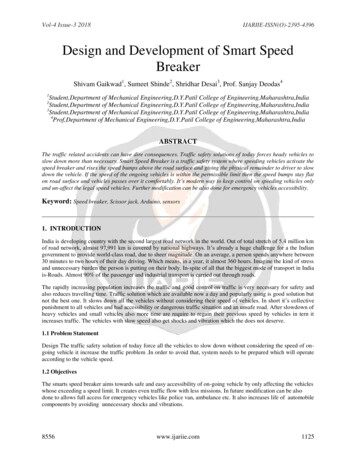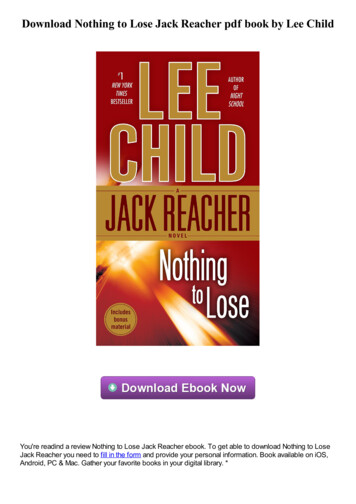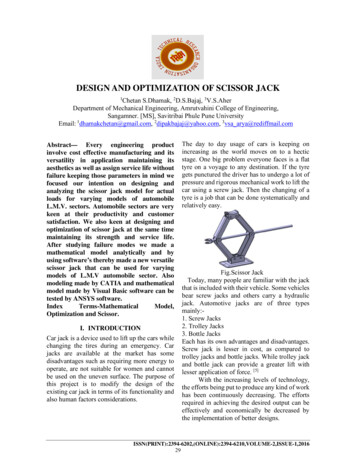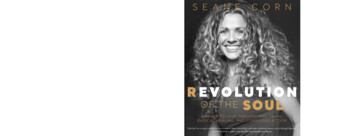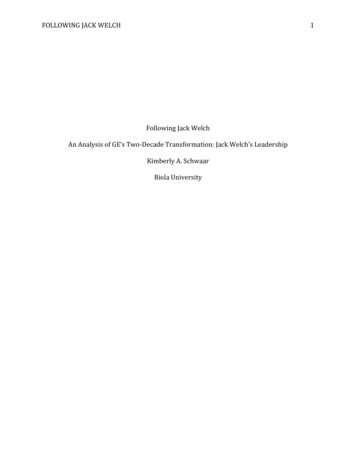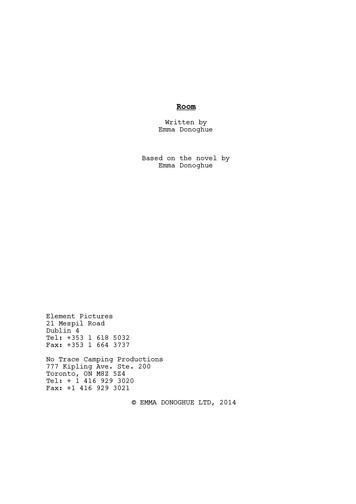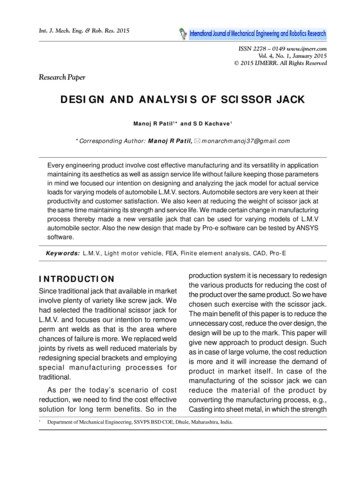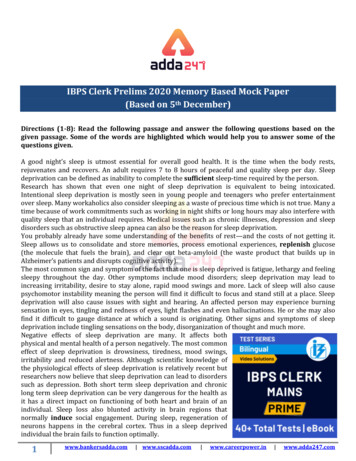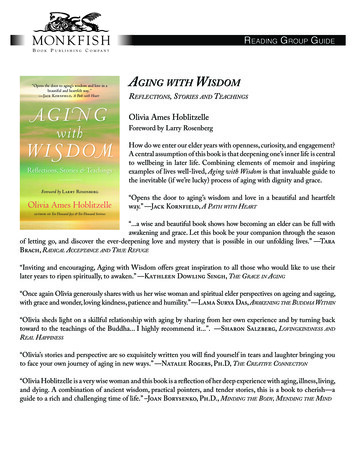
Transcription
READING GROUP GUIDE“Opens the door to aging’s wisdom and love in abeautiful and heartfelt way. ”— Jack Kornfield, A Path with HeartAG I N GwithWI S DO MReflections, Stories & TeachingsForeword by Larry RosenbergOlivia Ames Hoblitzelleauthor of Ten Thousand Joys & Ten Thousand SorrowsAGING WITH WISDOMREFLECTIONS, STORIES AND TEACHINGSOlivia Ames HoblitzelleForeword by Larry RosenbergHow do we enter our elder years with openness, curiosity, and engagement?A central assumption of this book is that deepening one’s inner life is centralto wellbeing in later life. Combining elements of memoir and inspiringexamples of lives well-lived, Aging with Wisdom is that invaluable guide tothe inevitable (if we’re lucky) process of aging with dignity and grace.“Opens the door to aging’s wisdom and love in a beautiful and heartfeltway.” —Jack Kornfield, A PATH WITH HEART“.a wise and beautiful book shows how becoming an elder can be full withawakening and grace. Let this book be your companion through the seasonof letting go, and discover the ever-deepening love and mystery that is possible in our unfolding lives.” —TaraBrach, RADICAL ACCEPTANCE AND TRUE REFUGE“Inviting and encouraging, Aging with Wisdom offers great inspiration to all those who would like to use theirlater years to ripen spiritually, to awaken.” —Kathleen Dowling Singh, THE GRACE IN AGING“Once again Olivia generously shares with us her wise woman and spiritual elder perspectives on ageing and sageing,with grace and wonder, loving kindness, patience and humility.” —Lama Surya Das, AWAKENING THE BUDDHA WITHIN“Olivia sheds light on a skillful relationship with aging by sharing from her own experience and by turning backtoward to the teachings of the Buddha. I highly recommend it.”. —Sharon Salzberg, LOVINGKINDNESS ANDREAL HAPPINESS“Olivia’s stories and perspective are so exquisitely written you will find yourself in tears and laughter bringing youto face your own journey of aging in new ways.” —Natalie Rogers, Ph.D, THE CREATIVE CONNECTION“Olivia Hoblitzelle is a very wise woman and this book is a reflection of her deep experience with aging, illness, living,and dying. A combination of ancient wisdom, practical pointers, and tender stories, this is a book to cherish—aguide to a rich and challenging time of life.” –Joan Borysenko, Ph.D., MINDING THE BODY, MENDING THE MIND
R eading G roup G uide :Questions for Discussionand Self-ReflectionSince Aging with Wisdom covers many subjects that invite further discussion, the following Reading GroupGuide can serve as a framework for book groups. I have included a number and range of questions, so thatparticipants can choose the most compelling ones for discussion.Part I When you hear the phrase “conscious aging,” what does it evoke for you? What would it mean to wake up toyour life in new ways, to approach situations more consciously? Can you give examples of ageism you’ve experienced and discuss their impact? They can be very subtle. Forexample, a pejorative comment, condescending language, hostile jokes about aging, excluded from conversation,etc. What is your orientation toward the inner life? Do you have a spiritual practice of any kind, and if not, discusshow and where you find meaning in your life.We need to acknowledge that some people may not be comfortable with the word “spiritual.” The centralquestion is how you inspire yourself when faced with life’s biggest challenges. Some people, for example, have aphilosophy of life that includes cultivating positive qualities like compassion, kindness, generosity, equanimity,joy, love, and so on. As you’ve grown older, whether or not you’ve experienced a “tectonic shift,” can you describe the ways in whichyou’ve recognized your growing older, and what, if any, changes you’ve made in your life—or would like tomake. Carl Jung and other wise ones have called old age the most valuable period in life. Discuss how you feel aboutthis statement, and whether it applies or not to your experience so far. What are the gifts of aging? In contrast, what are the challenges, disappointments, and harsh realities of aging? As we seek to balance the different elements of the aging process, what does the phrase “the grace of diminishment”mean to you? How do you relate to Teilhard de Chardin’s statement about hallowing one’s passivities anddiminishments? Have you recognized your particular responses to the challenges of aging? Examples: resistance, denial, controlmode, anger, fear, grief, etc. Almost inevitably, issues of independence and/or growing dependence arise in the later years. Some peoplefind it really difficult to accept help, even reject help as a sign of weakness. What are your feelings about thissubject? Whether or not you relate to the idea of a “forest monk” stage of life, has there been any shift towarddeepening your inner life, toward reflection or contemplation of some kind? Have you noticed any impulse to simplify or downsize or change some of the outer circumstances of your life? The ElderSpirit credo offers exceptionally rich possibilities for discussion. Reflecting on the idea of “soul time” (that some cultures have very different views of time from ours), how isthe quality of your life affected by time? Can you relate to the African porters who refused to go on becausethey were “waiting for their souls to catch up?”
Consider the challenging words of Rashani’s poem—brokenness, shatteredness, sorrow, fragility, darkness—and how you relate to these. How do we find “ the place inside that is unbreakable and whole/ Whilelearning to sing?” In telling the story of the old man, discuss the Dalai Lama’s statement that “there’s no reason to feel old justbecause the body is old.”Part II “The sacred circle that shelters your life.” Consider together what this might mean to you and share thesereflections with the group. The idea of taking refuge is common to many spiritual traditions. What are your refuges? What if you tried “to treat every moment as new experience?” What areas of your life might change? Have youever considered what it would be like to lose your sight, how much we take our senses for granted? In what ways do you connect with others through some practice of the heart, whether blessing, prayer, wishingthem well, or simply calling them into presence with love? Who are you now? Has your sense of self shifted as you’ve aged, perhaps as you’ve moved away from a nine tofive job, parenting responsibilities, and so on. Loss is a major issue for all of us as we age. (Physical problems, memory loss, diminished sight/hearing, loss ofdear ones, etc.) What are your thoughts/feelings about the issue of loss. How does your inner life help? We receive many memorable messages during our lives. What two or three have had a powerful impact over yourlife?Part III The story of Dhumavati challenges many of our assumptions, such as a goddess archetype that describes manycruel aspects of old age. How do you feel about this story? The subject of death presents us with the ultimate koan—a paradox or riddle, unanswerable by the rationalmind. What have been your experiences with death and dying, and what feelings arise for you as the groupturns to this discussion? In the various excerpts about death (Rilke, Tagore, Thoreau, Nouwen, Master Sheng Yen), what do you findthought provoking, inspiring, or challenging? Mysterious occurrences may occur around or after death. Have you experienced or heard any stories thatspeak to this mystery? The Five Remembrances, or similar calls to remember the subject of death, are considered important practicesin several spiritual traditions. How do these sayings strike you? We are seeing an epidemic of dementia-related diseases like Alzheimer’s. Have you been close to someonewith dementia and if so, what has that brought up for you? If one accepts that there is consciousness beyond the mind, how might this affect how one relates to someonewith dementia, particularly in the later stages? What are your feelings when you hear someone say that death is a gift?
Part IV As you reflect on this term “wayshower,” who have been wayshowers for you? What inspires you about them? Each of the six wayshowers in this section reveals something unique about their elder years. Can you namesome of those unique qualities and what stands out about that wayshower? Is there one wayshower with whom you particularly identify? In the Conclusion, return to the list of the book’s important guidelines and see which ones are most compellingfor you. Some may provide a springboard for further discussion. What is the most valuable message that you’ve taken from your reading of Aging with Wisdom?
About Olivia Ames HoblitzelleOlivia Ames Hoblitzelle is a writer and dharma teacher. For over forty years she has devoted herself to spiritual practice,primarily Buddhist meditation, which has deeply influenced her professional life, in particular how to integrate psychologyand meditation.After practicing as a psychotherapist with individuals, couples, and groups, she taught in the field of BehavioralMedicine where she pioneered the integration of meditation, yoga, and cognitive therapy with traditional Westernmedicine. As a Teaching Fellow at the Mind/Body Medical Institute, she developed and taught training programs forhealth professionals in new approaches to health and healing through Harvard Medical School. During her career, she hasintroduced contemplative practices in a wide variety of settings: government agencies, businesses, hospitals, organizations,churches, and most extensively in school systems to both teachers and students.Her first book, Ten Thousand Joys & Ten Thousand Sorrows: A Couple’s Journey Through Alzheimer’s, is an award-winningbook that has sold close to 15,000 copies and has been translated into four languages. As mentioned earlier, she has doneextensive promotion; many talks, conference keynotes, book events, radio and TV interviews as well as written articles andother pieces (introductions, chapters, etc.) for books and periodicals.As part of her commitment to contemplative life, Olivia has served on the boards of three organizations whosemissions are to encourage Buddhist teachings and practices in the West: Insight Meditation Society, Trijang BuddhistInstitute, and Dharma Friends. With her enduring commitment to peace and social justice, she was a founding boardmember and board chair of the Karuna Center for Peacebuilding. A lifelong educator, she was on the board of the PutneySchool and the Karuna School.Now an elder with two grown children and four grandsons, she lives in Massachusetts and spends as much time asshe can in Vermont where she grows vegetables, welcomes family and friends, and steeps herself in the glories of nature. Sheis also an artist committed to exploring the creative, spiritual, and healing dimensions of our lives.Monkfish Book Publishing CompanyMonkfish is an independent press publishing spiritual and literary books from a diverse range of perspectives. Genres includememoirs, wisdom literature, fiction, and scholarly works of thought. Monkfish books appeal to the seasoned or noviceseeker as well as to the general public looking for reliable sources on spirituality. The readers we had in mind when we beganMonkfish in 2002 were devoted spiritual seekers, the type whose passion for the spiritual quest would lead them to readacross a dazzling array of traditions: Buddhist, Jewish, Christian, Islam, Pagan, and more. It has always been our intent topublish works of spiritual authenticity for the general public as well as the specialist and scholar.Monkfish books are available in bookstores, libraries, universities, and online. Monkfish books are distributed to thetrade by Consortium Book Sales and Distribution in the US, by Publishers Group Canada in Canada, and by MacmillanDistribution internationally. Contributors and authors of Monkfish include Rupert Sheldrake, Terence McKenna, BradWarner, Jacob Needleman, Huston Smith, Elizabeth Cunningham, John Daido Loori, Ralph Abraham, Mirabai Starr andColin Wilson. Monkfish’s Provenance Editions are reprints of older, and sometimes nearly lost works by distinguishedthinkers such as Nobel Laureate Rabindranath Tagore, Zen Buddhist East/West pioneer D.T. Suzuki, the 1950’s spiritualicon Gerald Heard and H.G Wells.Monkfish’s eclectic mixture of spirituality books, while dealing with timeless subjects, nearly always shed light ontopical concerns, and have been widely discussed and reviewed in newspapers such as The New York Times, Washington Post,Kansas City Star, and Atlanta-Journal Constitution; in the publishing trade such as Publishers Weekly, Library Journal, Booklistand Kirkus; and in the spirituality media such as Yoga Journal, Spirituality and Health and Beliefnet.
— Jack Kornfield, A Path with Heart Reflections, Stories & Teachings. Reading gRoup guide: Questions for Discussion and Self-Reflection S ince Aging with Wisdom covers many subjects that invite further discussion, the following Reading Group Guide can serve as a framework for book groups.
